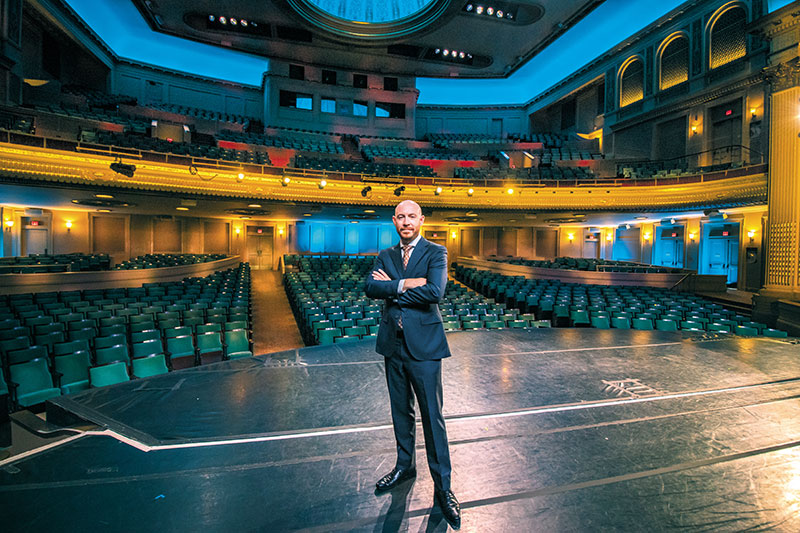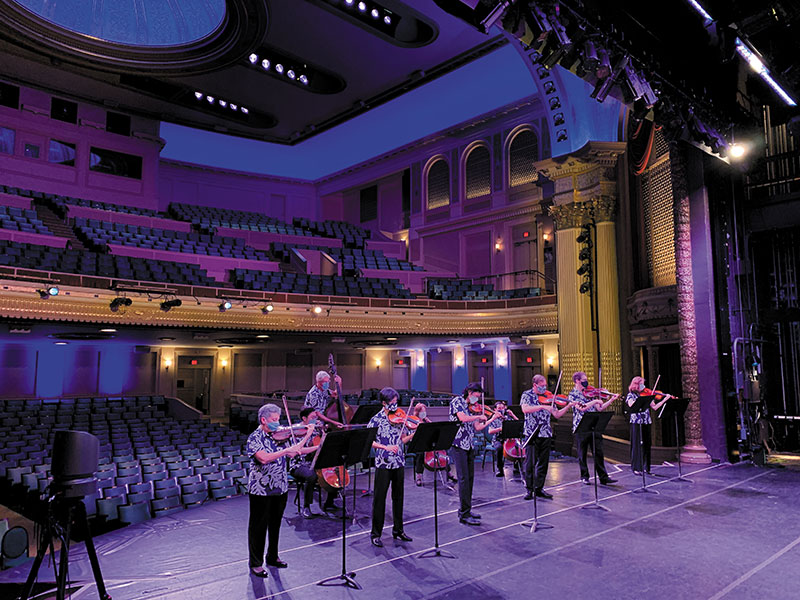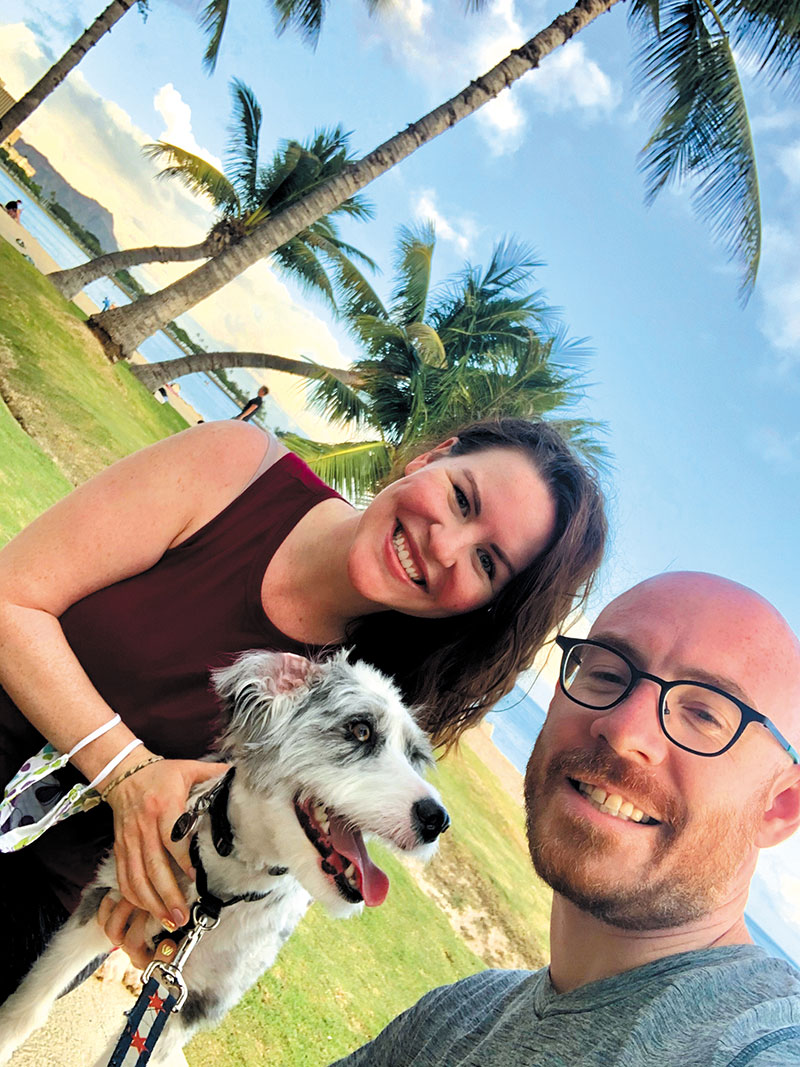Let The Music Play

It’s no longer business as usual for Hawai‘i Symphony Orchestra executive director Dave Moss, who is streaming concerts these days to keep dedicated fans entertained.
As strange as it sounds, it’s taken more than a half-year on the job for Dave Moss, Hawai‘i Symphony Orchestra’s executive director, to finally hear his musicians perform live. That moment came over the weekend after the full orchestra kicked off the fall season with its first-ever streaming concert.
Now, Moss is wondering just how long it will take before he’s finally (and properly) introduced to HSO’s other key members.
“I’ve yet to meet a lot of the people who are the biggest (fund-raising) supporters of the symphony. In fact, we’re going on almost seven months now and I’ve never even been in the same room with our board!” he says, chuckling over the odd but understandable circumstances in the Age of Coronavirus.
Thankfully, the symphony’s new boss is a patient man who knows that formal introductions and gatherings will ultimately come. Until then, he’ll continue doing what he was in large part hired to do: turn the flat notes generated by a global pandemic into a crescendo of fresh opportunities for the second oldest orchestra west of the Rocky Mountains.

Hawai‘i Symphony Orchestra will engage music lovers virtually Saturday night from Hawai‘i Theatre Center, where the online concert “From Chaos to Calm” will be staged. PHOTO COURTESY HAWAI‘I SYMPHONY ORCHESTRA
Already, he’s smartly chosen to push HSO into the digital realm. With the organization’s launch of its online series “Sounds of Resilience” last week (see more on page 21), Moss is nimbly navigating his way around current safety restrictions with an eye toward an eventual return to in-person concerts at Hawai‘i Theatre Center and other venues.
“If there’s an opportunity of doing outdoor performances for physically distanced audiences, we’ll do that,” he says. “Music still brings us together and I never want the experience of attending the symphony to be something that’s not social, that’s not interactive.
“But we have to find a safe way before we do this.”
At the moment, that means entertaining music lovers through live-streaming media, something Moss calls “a unique type of engagement for the symphony-orchestra audience.” The pay-per-view format also happens to be appealing because it’s an affordable solution for many in these financially strapped economic times.
“For each performance, you are able to buy a $20 ticket,” Moss explains. “So, if you have a household of 12, you’re getting a really good discount because everyone can join in and watch.”

After moving from Chicago earlier this year, Dave Moss and wife Kate settled in Kaka‘ako with their Australian shepherd-poodle Lena. PHOTO COURTESY DAVE MOSS
Early reactions to the streaming format have been favorable.
“We’ve had an overwhelming response and have sold about 350 or so tickets,” noted Moss just days before the Sept. 26 concert “Galaxy of Strings.”
“I know it doesn’t really seem like a large number, but for all the other things going on currently, and for the switch to a new medium like this, I’ve been very impressed.”
Just as impressive has been the dedication of HSO’s 64 core musicians and 20 additional instrumentalists normally called in for larger performances, all of whom have stayed sharp since the remaining five weeks of the 2019-20 season were shelved last spring.
“I arrived in Hawai‘i on March 6, had just four days to get settled, started my job on March 10 and five days in, we had to make the very difficult decision to cancel the rest of the season,” Moss recalls. “But our musicians moved quickly to adapt to the circumstances and have been very active over the summer teaching and practicing on their own, and really lending their voices to what the future of the organization will look like.”
Originally from the suburbs of Chicago, Moss was introduced to the violin at age 2 and raised on the Suzuki method of playing the instrument.
“For me, music has been arguably my first language,” he says.
Neither his dad (an engineer) nor his mom (a nurse) had musical backgrounds, but they were supportive of Moss and his two older siblings when it came to full immersion in the performing arts.
“I think back to my high school days and my dad would drive me to orchestra rehearsals, and we must have put 1,000 miles in the car every single week driving around Chicago,” recalls Moss. “They were so dedicated to having music in our lives.”
The early music foundation paid off handsomely as Moss wound up attending Oberlin Conservatory of Music in Ohio and later obtaining his master’s from The Juilliard School in New York City. From that point forward, he hooked up with several different orchestras and enjoyed “a big freelance career,” playing chamber music in both the Windy City and the Big Apple.
“My claim to fame was as a violist on a little show called Hamilton,” he says proudly.
Despite his talent with the violin, Moss also envisioned himself as something more than just a performer. Or as he puts it, “I was a musician with a chip on my shoulder, and I believed I could run an organization.”
To merge both his creative side with his burgeoning interests in business, Moss obtained an MBA in finance and eventually landed a job with the Haymarket Opera Company as its executive director. During his three-plus years there, he helped the small opera troupe triple in size.
“It was a niche organization,” explains Moss. “We presented opera exclusively from the Age of Enlightenment using period instruments, period staging and period singing. For me, it wasn’t about opera, but about the community we were creating.
“That community is one of the things I was looking for in my next organization, and when I heard about this position at HSO, and knowing so much about the history of the symphony and what I’ve since come to know as the aloha spirit, I jumped at the opportunity to apply.”
Part of what makes Moss excited about HSO’s future is the new direction in which it’s heading.
“It can no longer be business as usual for us. In fact, that’s impossible,” he says. “Building a resilient organization is building one that cannot only react, but one that plans for the circumstances we might be facing in the years to come.”
One such plan calls for infusing more Hawaiian culture into what the organization does on stage.
“It’s those types of projects that I’m most interested about, those that are reflected of all of Hawai‘i and not just Western classical music,” says Moss, who resides in Kaka‘ako with wife Kate and their Aussiedoodle named Lena.
He continues: “I am someone who likes to be challenged, likes to think creatively, and likes to think about what the future of the arts will look like. I remember during the interview process for this job that one of the board members asked me, ‘What is success to you?’ I said that success isn’t necessarily a budget size, or the types of performances that we do, but something that when the rest of the mainland orchestras look at us, they will say, ‘They did it right; they reflected their community in an organic way; and they really lived up to their mission of serving Hawai‘i.’
“Ultimately,” he concludes, “I felt that the crux of what the organization was going through made it the right time for me to come in and join the future.”
HSO GOES ONLINE
Hawai‘i Symphony Orchestra will present its second online concert for stay-at-home audiences Saturday evening from Hawai‘i Theatre Center. The first notes begin at 7:30.
The streaming concert “From Chaos to Calm” will feature works by Johann Sebastian Bach (Concerto for Oboe and Violin), Dmitri Shostakovich (Chamber Symphony), William Grant Still (Mother and Child for String Orchestra) and Antonin Dvorak (American Quartet Finale).
The concert is part of HSO’s fall season lineup for its “Sounds of Resilience” series. Three additional performances are planned before the end of the year; those dates and times are expected to be announced during Saturday’s performance.
Tickets are $20 and may be purchased at myhso.or/sounds-of-resilience or hawaiitheatre.com.





